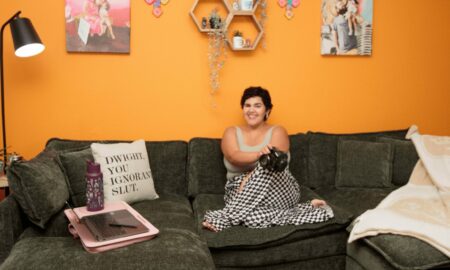

Today we’d like to introduce you to Alicia Philley.
Hi Alicia, please kick things off for us with an introduction to yourself and your story.
Some of my first memories are watching my grandma paint wildflower-filled landscapes on her very hot, screened in back porch. I would sprawl on the floor and draw copies of birds from one of her reference books. I also loved to read and write. That along with my desire to focus attention on people fighting for change in the world, drew me toward journalism (this was pre-facebook and social media!) But I couldn’t stop processing the world around me through paint and colors.
Moving to New York City for a magazine job after college introduced me to new ideas about what art can mean for the maker and the viewer. I was surrounded by amazing and eclectic art supply stores and creative people who worked day jobs to support their creative habits. While my weekdays were spent working my way up from fact checker to reporter to writer/editor, evenings and weekends I was often exploring new art mediums, going to museums and galleries, and sketching on the subway or in the park. Friends encouraged me to show my art and after several years of coffee shop and bar displays, I had my first small gallery show.
Seven years into living this double life, I went through a huge life-altering event: The 9/11 attacks on the World Trade Center. Like so many people around the city, I was laid off. It was a hard year, living on unemployment, feeling so much grief, heaviness, and uncertainty. Making art and looking at art became a lifeline and I slowly realized that writing wasn’t the only way to have a positive impact. Artists were doing it all around me. The stories they told through their work was sustaining me and so many around our city. I went back to school and completed a BFA in painting at Hunter College. It wasn’t an easy transition, waiting tables and temping was a world away from my high-paying job as an editor with a small staff of writers. But I was so happy! Twenty years later I am still so grateful to have learned how to tell stories through the visual language of paint.
I’m sure you wouldn’t say it’s been obstacle free, but so far would you say the journey have been a fairly smooth road?Once I accepted and embraced that I am a painter, I’d like to say it was a smooth ride. But that’s not generally how life works. The hardest parts for me were when I couldn’t be immersed in my work. My husband and I left New York to have a more affordable life, so I could paint instead of working a day job, while also raising our daughters. After several years of growing health issues that weren’t resolving for our older kid, I decided to take time off from showing my work to focus on her needs. It was a longer pause than I could have anticipated, seven years before I would make a new body of paintings. I don’t regret that time even though it was so difficult; my daughter is stronger, and I learned a lot about myself.
To fill my creative need I took up sewing, knitting, crocheting, needle felting, any hand work that I could picked up and put down easily. I found a community of creative and crafty women who helped me rethink what it means to be an artist and maker. And most importantly, when I was finally able to rebuild and re-enter my studio, I had developed a new way of thinking about my work and a new way of looking at the world around me. In the six years since I stepped back into my career, my work has shifted and developed in ways I would never have anticipated. I am also much more driven to understand the business side of being an artist, to create opportunities for myself and to take risks with my work. I see my very creative, artistic daughters growing up and I want them to believe that being an artist is a viable path in life. I want them to know that when you don’t give up, when you learn from the difficult moments (or years), that is how you succeed.
As you know, we’re big fans of you and your work. For our readers who might not be as familiar what can you tell them about what you do?
I am fascinated by the experience of sight; the ways we perceive subtle motion, reflective light, and color in natural settings. Moving to Austin and spending so much time with my kids in the many green spaces around town has heavily influenced my painting language. My work is known for sharp-edged ribbons of color that curve and swirl on pigment-stained wood panels. Each painting is an emotional/sensory memory of elements from those spaces.
I started using masking tape in art school, a simple tool to create a very exacting and straight line. At Hunter College, where the studio fine arts program was initially developed by abstract painters, I learned about color theory and ways to apply that knowledge to create an illusion of space or movement. Turning a flat canvas into a depth-filled world with just two or three colors; it was pure magic!
For years I continued making very minimal and linear paintings, perfecting my skills and trying to figure out my unique voice. When I returned to painting seven years ago, the straight lines didn’t make sense anymore. My world was no longer the tall, angular architecture of New York. It was filled with winding paths, swaying trees, shimmering creeks, color-shifting clouds. I slowly incorporated the sense of motion, joy and wonder that I felt outdoors back into my studio work. My colors got brighter; my marks became freer. Once I started painting on wood panels, which made it easier to control and refine the linework, I realized the wood’s grain lines could also be part of my painting language. I use the tree’s ring patterns to further that connection to nature and to create a more expansive feeling of space.
Recently I began working with custom-shaped panels; each painting’s edge is an extension of the natural shapes and flowing patterns of the woodgrain. I’m so happy that the art I most love to make is connecting with people as well. In the past few years, I’ve shown regularly in Austin and around Texas, including 6th Street Gallery by CAMIBAart, Artspace 111, Cloudtree Studios and Gallery, Vault Stone Shop, Link & Pin, Art84 and the Georgetown Art Center. This past year I put my energy into showing work nationally and my paintings were exhibited in six different out-of-state galleries, including Pleiades gallery and Equity gallery in New York City, and the Jones Gallery in Kansas City.
Is there anything else you’d like to share with our readers?
If you want to see one of my paintings in person, stop by the “People’s Gallery,” a juried show that will be up through the end of 2021 at the beautiful Austin City Hall. I’m also excited to share some new directions for my work: Digital and sculptural paintings. This summer I co-curated a show for the West Wing Project Space in New York, which featured six of my new artworks. These are available as archival prints through July of 2022 in the gallery’s marketplace at https://www.nyartistsequity.org. And I will continue to show and offer prints of new digital paintings through a partnership with fine art printer 10000Museums.org. And finally, I’m about to announce a huge project of outdoor, sculptural paintings that will show later next year in one of my favorite Austin green spaces. I’m still working out the details with the organization, so check out my website and sign up for my newsletter for updates!
Contact Info:
- Email: aliciaphilley@mac.com
- Website: www.aliciaphilley.com
- Instagram: https://www.instagram.com/alicia_philley/



 Image Credits
Image Credits
Detail of “The Violet Crown Trail,” acrylic on custom shaped wood panels, 52″ x 58″, 2020. Photo courtesy of the artist. “The Complete/Incomplete Timeline,” acrylic on 47 wood panels, 12″ x 6″ and 6″ x 6″, 2020. Photo courtesy of the artist. Artist in front of “Out the Window and Through the Trees,” acrylic on two wood panels, 36″ x 48″, 2021. Photo credit: David Bailie, @ddbailie. “Mountain Pass,” acrylic on wood panel, 48″ x 48″, 2020. Photo credit: David Bailie, @ddbailie.










